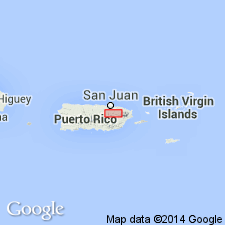
- Usage in publication:
-
- Cancel Breccia*
- Modifications:
-
- Named
- Dominant lithology:
-
- Tuff
- Breccia
- Lava
- AAPG geologic province:
-
- Caribbean region
Summary:
The Cancel Breccia, here named, consists of a heterogeneous assemblage of reddish- to purplish-gray tuff breccia and lapilli tuff with flow breccia and lava in the lower part, confined to the Naranjito and Corozal quadrangles. Unconformably overlies the El Ocho Formation; unconformably underlies the Santa Olaya Lava. Thickness is more than 2,000 m. Age is Early and Late Cretaceous based on correlation of the Cerro Gordo Lava with the Lapa Lava Member of the Robles Formation.
Source: GNU records (USGS DDS-6; Reston GNULEX).

- Usage in publication:
-
- Cancel Breccia*
- Modifications:
-
- Overview
- AAPG geologic province:
-
- Caribbean region
Summary:
The Cancel Breccia occurs in eastern Puerto Rico and consists of andesitic tuff breccia, volcanic breccia, and lava. Maximum exposed thickness is 2000 meters. The Cancel is of Late(?) Cretaceous age.
Source: GNU records (USGS DDS-6; Reston GNULEX).
For more information, please contact Nancy Stamm, Geologic Names Committee Secretary.
Asterisk (*) indicates published by U.S. Geological Survey authors.
"No current usage" (†) implies that a name has been abandoned or has fallen into disuse. Former usage and, if known, replacement name given in parentheses ( ).
Slash (/) indicates name conflicts with nomenclatural guidelines (CSN, 1933; ACSN, 1961, 1970; NACSN, 1983, 2005, 2021). May be explained within brackets ([ ]).

